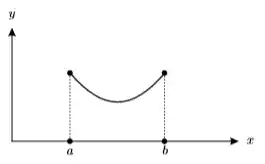In the catenary variational problem we have to find the curve that results from letting a weighted string with fixed length hang between two endpoints, and waiting until it minimizes its potential energy:
The constrained lagrangian for this problem is: $$L(y(x),y'(x))=(y(x) - \lambda)\cdot \sqrt{1+y'(x)^2}$$
What is wrong with my approach?
We have to solve the Euler-lagrange Equation, which is:
$$L_y=\frac d{dx}L_{y'}$$
So we find the derivatives of $L$: $$L_y=\sqrt{1+y'(x)^2}$$ $$L_{y'}= (y(x)-\lambda)\frac {y'(x)}{\sqrt{1+y'(x)^2}}$$ $$\frac d {dx} L_{y'}= \frac {y'(x)^2}{\sqrt{1+y'(x)^2}}+ y''(x)\cdot (y(x)-\lambda)\frac {1}{({1+y'(x)^2})^{3/2}}$$
This results in the Euler-Lagrange equation: $$\frac {y'(x)^2}{\sqrt{1+y'(x)^2}}+ y''(x)\cdot (y(x)-\lambda)\frac {1}{({1+y'(x)^2})^{3/2}}=\sqrt{1+y'(x)^2}$$
What surprised me is that according to this website, the Euler-lagrange equation looks very different:
**
There is not even a $y''(x)$ in their Euler-Lagrange equation. What am I doing wrong?
ps. here is another question that I posted where I seem to be making a very similar mistake, so I must fundamentally misunderstand something about the calculus of variations and the Euler-Lagrange Equation.
EDIT: (based on @user121049's comment): I've tried doing what you said, and it gets me to the same result, so this solves my question. (But I'm still not sure about the final solution) :
$$y''\frac {(y-\lambda)} {1+y'^2}=1 \implies \int y'' \cdot \frac {y'}{1+y'^2}dx=\int \frac {y'}{y-\lambda}dx$$ Which implies $$\int \cdot \frac {y'}{1+y'^2}d(y')=\int \frac {1}{y-\lambda}dy\implies \ln|1+y'^2|=2 \ln(|y-\lambda|^2)+C\implies$$
$$1+y'^2=c_!\cdot(y-\lambda)^2$$
This Answers my question.
Now to solve it further: substitute $z(x)=y(x)-\lambda$ to get $z^2=c_1(1+z')\implies z'=\sqrt{\frac {z^2 -c_1}{c_1}}\implies c_1\int \frac 1 {\sqrt {z^2-a}}dz=x+c_2\implies \ln|\sqrt {z^2-c_1}+x|=\frac x c_1 +c_2\implies$ $$y(x)=z(x)+\lambda =\sqrt {\frac {c_2}{x^2}e^{\frac x {c_1} } +c_1}+\lambda$$
Is this correct? It doesn't seem like it describes the problem.

